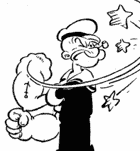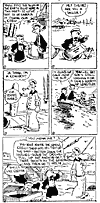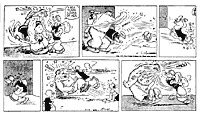|
To designate Popeye
the first superhero in comics, which many enthusiasts are prone to do,
is to fall considerably shy of properly assessing the cartooning achievement
of his creator, Elzie C. Segar. It is the 75th anniversary
this year of Popeye's debut in the newspaper funnies, but the strip
he appeared in (first as a mere walk-on), Segar's loping comic strip
saga, Thimble Theatre, had been going for almost a decade without the one-eyed
sailor. With the arrival of Popeye, a minor miracle took place on Segar's
tiny stage. Popeye turned out to be the perfect vehicle for expressing
Segar's narrative and comedic talents.
With a character so congenial to his genius, Segar converted
what had been an adequate but undistinguished comic strip into a classic,
a masterpiece of the art form. Born in 1894 and raised in the When the Herald was absorbed by the Hearst empire the next year, Segar went
to the Chicago American, and
on June 1, 1918, he employed a simple, bigfoot cartooning style to do
Looping
the Loop, a vertical
strip that made comic commentary on movies, plays, exhibitions, and
other newsy doings in downtown Chicago.
Late in 1919, Segar was sent to Hearst's New
York Journal, presumably to do another vertical format feature.
For the Journal, one of cartooning's legendary pioneers, Ed Wheelan, had been
producing a motion picture parody strip, Midget Movies, in which Wheelan's repertory cast of actors and actresses
"starred" in stories that spoofed popular movies of the day.
Wheelan left Hearst in 1919 to resurrect his strip as Minute
Movies for the George Matthew Adams Service, and Segar arrived at
the Hearst works to take Wheelan's place.
Following the now-established custom of naming comic strips of
this kind as if they were miniature motion picture houses, Hearst christened
Segar's endeavor Thimble Theatre, and the curtain went up
Thimble Theatre was supposed to parody movies
and stage plays, and Segar cast the strip with "actors" who
would take parts in the lampoon productions:
Willy Wormwood, a moustache-twirling villain akin to Desperate
Desmond; the pure and simple heroine with a hysterical scream in her
throat, Olive Oyl; and her stalwart (if not overly smart) boyfriend,
Harold Hamgravy (who would soon lose his first name and become Ham Gravy).
But after a few short weeks of daily or weekly productions along
the intended line, Segar abandoned the original plan and focused instead
on his actors and their real (as opposed to "reel") adventures. And with the introduction shortly thereafter
of Olive's brother, the pint-sized Castor Oyl, the strip found its footing. Castor
Oyl was, in Segar's words, "Olive's foolish brother, not exactly
half-witted but exceedingly dumb. Just
this dumb: when Olive's pet duck
fell into a deep hole and no one could extricate it, Castor came by
with a water hose and floated the duck to the top. He was clever in
his own inimitable way. He even
invented coal that would last forever, and he fireproofed safety dynamite
so it couldn't explode." But Castor wasn't merely kooky.
He was maniacally ambitious.
He wanted money and success, women and power.
Having almost no special abilities that would enable him to achieve
these ends, he pursued his aims with no more than single-minded, dogged
determination. As an obsessive seeker after wealth and power,
Castor was the perfect 1920s protagonist--a caricature of the materialistic
go-getter, the icon of the age. He
soon emerged as the star of the strip. Castor's
greedy ambitions motivated the strip throughout the decade, one get-rich-quick
scheme after another. Daily installments ended with comic punchlines,
but the story of one day's installment did not end with the last panel's
laugh: Segar strung the dailies together, stretching
stories out for a week or more. Soon
the stories meandered on for months, but such was Segar's comic inventiveness
that people enjoyed the ramble. One
of Segar's devices for creating suspense and maintaining interestingly
comic continuity was to introduce wildly eccentric characters into his
stories. The strip would focus for days--even weeks--on
the Dickensian quirks and foibles of some minor character. As this character kept us entertained, Segar
could, at the same time, inch his story along, day by day. Popeye
was one of these characters. In one
of his get-rich-quick plans, Castor turns gambler. But not before he has a sure-fire system:
his uncle has given him a Whiffle Hen, a good luck bird that
guarantees winning at games of chance for anyone who rubs the three
hairs on the bird's head. Castor decides to take the Whiffle Hen to an
offshore gambling hell called "Hey
there!" says Castor, "Are you a sailor?" Confounded by Castor's inability to perceive his occupation from his
nautical garb and demeanor, the sailor replies with biting sarcasm: "Ja think I'm a cowboy?" "Okay–you're
hired," says Castor. Popeye
is clearly no fool. When he sees
that he must do the work of a 12-man crew, he demands the pay of twelve
men. And so off they sail for It was on this voyage to Crack! But it wasn't Ham Gravy's fist
that set off the explosion; it was Popeye's. Ham Gravy, angrily, with black eyes: "You're just what I thought you was--a low-down roughneck.
I won't fight with
you." Popeye was ready with his fists
from almost the moment of his introduction.
Rather than redress injustice with words and sweet reasonableness,
Popeye simply bopped it on the nose. Waugh observes: "The readers
liked this. Here was someone
who did what, ideally, they would have done.
Letters began to pour in to Segar, praising the new character. Segar took the hint. If they wanted a fight, they'd get it." Before the fighting got too fierce, though, Segar made his
fighter a gladiator who could last through any series of battles. Since he reacted with his fists instead of his
feet or his mouth (as did the other less violence-prone characters in
the strip), Popeye seemed, in comparison, more than ordinarily strong. What began as a simple comic comparison between
a roughneck sailor and a pint-sized schemer became, as Segar fine-tuned
the focus of his comedy, an exaggerated comic contrast. Popeye's ordinary (probably) prowess at waterfront
tavern brawling was elevated over the years to superhuman strength as
he proved himself again and again superior to a series of successively
more intimidating foes. Before
too long, his reputation as a superman was well established. The process began almost immediately when Segar enabled
Popeye to survive otherwise mortal gunshot wounds. Shot sixteen times during the escape from Segar's finishing touch was a stroke of graphic comic genius. Popeye's bulging forearms, those watermelons
attached to his body with pipe cleaners, give "ham-fisted"
a visual metaphor. Although the
graphic device defies anatomy and affronts common sense, it succeeds
remarkably in suggesting pugilistic power.
Popeye's arms evoke the velocity of his swing:
it's as if the centrifugal force of repeated roundhouse punches
have shoved all the sailor's muscles to his extremities. His arms suggest the enormous impact of his
blows: ballooning around his
hands, his arms convert his fists to sledge-hammers that gain more striking
force by being at the ends of long handles.
In comparison, the bulging biceps of conventionally constructed
comic book superheroes seem scarcely sufficient to their tasks–as if
too far removed from the point of the impact, the striking fist.
All Popeye's muscles–and most of his weight–are bunched just
where they'll be felt the most: right
behind his knuckles. Conceptually
and visually, Popeye is the comic epitome of the perfect fighter. Popeye's fame and his association with spinach were derived
more from the Fleischer Studio's animated version of the strip, which
series started in the summer of 1933, than from the strip itself. Segar
had forced Popeye to consume a bowl of spinach on Segar made canny use of his hero's abilities. He was inventive enough that he didn't need
to rely on Popeye's amazing capabilities for his stories. The Thimble
Theatre stories continued to roll on, introducing more minor characters
with comic eccentricities and involving them in fantastic plots–sometimes
ignoring for weeks on end the spectacular abilities of the strip's star
performer. Still, Segar knew
better than to deny his readers indefinitely the pleasure of seeing
Popeye in vivid action. Eventually,
the cartoonist would unleash his hero, and Popeye would proceed with
businesslike dispatch and no fanfare at all to settle the hash of the
bad guys with a few unequivocal punches. Our immense satisfaction at this turn of events in every
story derives from two aspects of the strip:
the nature of the bad guys and the nature of the avenging hero. Elementary:
the bad guys deserve what they get.
They are invariably self-seeking and heartless: brutal and inhuman, their very excesses are
exaggerated to the point of comic caricature (hence, our enjoyment of
the strip even while we wait for Popeye to set things right). In contrast to this extreme (and therefore comic)
villainy stands the strip's hero. Popeye
burns with moral fervor. There
are few "grays" for Popeye: he knows what's good and what's evil, and he
has no doubts about which he should choose.
He is nonetheless kindly and charitable, willing to forgive most
human foibles. But if a supposed
foible is revealed as fully-fledged villainy, Popeye moves inexorably
to redress the wrong. In this,
as Waugh says, Segar captured the essential aspect of the American character–the
impulse to act with pragmatic decisiveness. "Popeye," Waugh says, "is action incarnate.
He wastes energy; his temperament is ardent; even his good deeds
are done with intensity, with fierce face and furious tempo. ... He
proceeds always under full steam, with fluttering flags and bands playing.
God bless him, he is Popeye
has gone through several cartooning custodians in the decades following
Segar's death in 1938. Tom Sims
inherited the writing assignment, and his scripts were illustrated,
at first, by Doc Winner, then by Bill Zaboly. After Sims left in the early
1950s, Ralph Stein took over, but in 1958, the whole assignment fell
to Bud Sagendorf, who had been the heir
apparent all along: he had started assisting Segar in the early 1930s
while still a teenager. Sagendorf wrote and drew Thimble
Theatre, daily and Sunday, until 1986, when the daily was taken
over by erstwhile underground cartoonist, Bobby
London, who carried on in Segar's manic tradition but was summarily
taken off the strip in the summer of 1992 when he seemed about to take
a position supporting abortion. It was a circumstance of surpassing
oddity: Olive gets an ugly doll in the mail and wants to get rid of
it; some clerical hangers-on overhear her and Popeye talking about returning
the doll "to its maker" and assume Olive is talking about
a pregnancy and abortion. The sequence was approved by King Features
and distributed–and published. Then And if this diatribe isn't enough on Segar's Popeye–if, in other words, you'd like to know more about the times in which the character was created and how that contributed to his success and about nuances of Segar's storytelling style, and if you'd like to know how else Segar achieved brilliance a second time with a subsidiary character named Wellington J. Wimpy–well, then you need a copy of my book on the "aesthetic history" of the comics, The Art of the Funnies, which has an entire chapter on Segar (from which the foregoing was pirated mercilessly). For a preview of the book, click here. |
||



